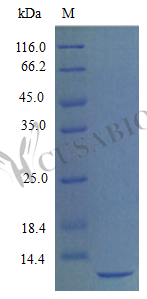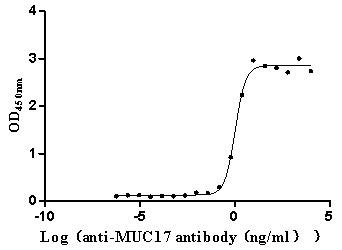Recombinant Mouse Stromal cell-derived factor 1 protein (Cxcl12), partial (Active)
In Stock产品详情
-
纯度:>97% as determined by SDS-PAGE.
-
内毒素:Less than 1.0 EU/μg as determined by LAL method.
-
生物活性:Fully biologically active when compared to standard. The biological activity determined by a chemotaxis bioassay using human peripheral blood monocytes is in a concentration range of 50-100 ng/ml.
-
基因名:
-
Uniprot No.:
-
别名:Cxcl12; Sdf1; Stromal cell-derived factor 1; SDF-1; 12-O-tetradecanoylphorbol 13-acetate repressed protein 1; TPAR1; C-X-C motif chemokine 12; Pre-B cell growth-stimulating factor; PBSF; Thymic lymphoma cell-stimulating factor; TLSF
-
种属:Mus musculus (Mouse)
-
蛋白长度:Partial
-
来源:E.Coli
-
分子量:8.0 kDa
-
表达区域:22-89aa
-
氨基酸序列KPVSLSYRCP CRFFESHIAR ANVKHLKILN TPNCALQIVA RLKNNNRQVC IDPKLKWIQE YLEKALNK
-
蛋白标签:Tag-Free
-
产品提供形式:Liquid or Lyophilized powder
Note: We will preferentially ship the format that we have in stock, however, if you have any special requirement for the format, please remark your requirement when placing the order, we will prepare according to your demand. -
缓冲液:0.2 μm filtered PBS, pH 7.4 ,lyophilized
-
储存条件:Store at -20°C/-80°C upon receipt, aliquoting is necessary for mutiple use. Avoid repeated freeze-thaw cycles.
-
保质期:The shelf life is related to many factors, storage state, buffer ingredients, storage temperature and the stability of the protein itself.
Generally, the shelf life of liquid form is 6 months at -20°C/-80°C. The shelf life of lyophilized form is 12 months at -20°C/-80°C. -
货期:5-10 business days
-
Datasheet & COA:Please contact us to get it.
相关产品
靶点详情
-
功能:Chemoattractant active on T-lymphocytes and monocytes but not neutrophils. Activates the C-X-C chemokine receptor CXCR4 to induce a rapid and transient rise in the level of intracellular calcium ions and chemotaxis. Also binds to atypical chemokine receptor ACKR3, which activates the beta-arrestin pathway and acts as a scavenger receptor for SDF-1. Binds to the allosteric site (site 2) of integrins and activates integrins ITGAV:ITGB3, ITGA4:ITGB1 and ITGA5:ITGB1 in a CXCR4-independent manner. Acts as a positive regulator of monocyte migration and a negative regulator of monocyte adhesion via the LYN kinase. Stimulates migration of monocytes and T-lymphocytes through its receptors, CXCR4 and ACKR3, and decreases monocyte adherence to surfaces coated with ICAM-1, a ligand for beta-2 integrins. SDF1A/CXCR4 signaling axis inhibits beta-2 integrin LFA-1 mediated adhesion of monocytes to ICAM-1 through LYN kinase. Plays a protective role after myocardial infarction. Induces down-regulation and internalization of ACKR3 expressed in various cells. Has several critical functions during embryonic development; required for B-cell lymphopoiesis, myelopoiesis in bone marrow and heart ventricular septum formation. Stimulates the proliferation of bone marrow-derived B-cell progenitors in the presence of IL7 as well as growth of stromal cell-dependent pre-B-cells.
-
基因功能参考文献:
- superparamagnetic iron oxide nanoparticles also stimulated CXCR4 (C-X-C chemokine receptor type 4) expression and CXCR4-SDF-1 (Stromal cell-derived factor 1) signaling in mesenchymal stem cells. PMID: 29734748
- This study regarding high SDF-1 levels in our mouse model of ototoxicity would play a major role in the development of therapeutic agents using MSC homing. PMID: 29430461
- CXCL12-CXCR4 signalling is essential for the correct patterning of aortic arches and pulmonary arteries during development. PMID: 29016745
- Data (including data from studies in knockout mice) suggest that adipocyte autocrine function involving Sdf1 regulates insulin resistance; Sdf1 gene expression correlates with insulin-desensitized conditions in adipocytes but not other tissues (liver, skeletal muscle); adipocyte-specific ablation of Sdf1 enhances insulin sensitivity in adipose tissues and in whole body. PMID: 29581126
- postnatal CXCL12 signaling promotes a specific interneuron circuit that inhibits medial prefrontal cortex activity PMID: 27497284
- Study reports that stromal cell-derived factor-1alpha elevated or therapeutically administered in ischemic wounded tissue can stimulate both local endothelial cells (EC) and bone marrow-derived endothelial progenitor cells (EPC) to express reciprocally E-selectin/ligand pairs and thereby enhance EPC-EC interactions. PMID: 27713493
- suggest that miR-155 modulates SHIP-1 expression that subsequently affects CXCL12-CXCR4 signaling axis via Akt activation PMID: 28174416
- s produced recombinant CXCL12 and CXCL12(5-67) and evaluated their effect in murine adult NSCs migration and survival in vitro. We showed CXCL12(5-67) does not promote NSCs migration, but does induce cell death. PMID: 28623786
- Study demonstrates that CXCR4/CXCL12 axis can limit oxidative stress injury in hematopoietic stem cells (HSCs) by reducing mitochondrial oxidative stress. CXCL12 has a direct rescue effect on oxidative stress-induced HSC damage at the mitochondrial level. PMID: 27886253
- a defect of CXCL12 promoter histone acetylation may represent an additional process participating in CXCL12 expression extinction in colon cancer PMID: 28418886
- The structure of murine germinal centers (GC) and the localization of GC B cells are impaired when CXCL12 is unable to bind to cellular or extracellular surfaces. PMID: 28193885
- These findings indicate that the CXCL12alpha-CXCR4 axis plays an important role in the regeneration of the neuromuscular junction after motor axon injury. PMID: 28559442
- Here, we show that cabozantinib rapidly eradicates invasive, poorly differentiated PTEN/p53-deficient murine prostate cancer. This was associated with enhanced release of neutrophil chemotactic factors from tumor cells, including CXCL12 and HMGB1, resulting in robust infiltration of neutrophils into the tumor. PMID: 28274958
- nitration on Tyr7 under inflammatory conditions is a novel natural posttranslational regulatory mechanism of CXCL12 which may downregulate the CXCR4-mediated inflammatory and tumor-promoting activities of CXCL12 PMID: 27566567
- SDF-1 is secreted shortly after UPEC infection initiating immune cell accumulation. PMID: 28683322
- The data suggest that SDF-1beta provides synergistic effects supporting BMP-2-induced, BMSC-mediated bone formation and appears suitable for optimization of bone augmentation in combination therapy protocols. PMID: 26227988
- Hyaluronic acid-laminin hydrogels increase neural stem cell transplant retention and migratory response to SDF-1alpha in a manner critically dependent on signaling via the SDF-1alpha-CXCR4 axis. PMID: 27645115
- The Function of SDF-1-CXCR4 Axis in SP Cells-Mediated Protective Role for Renal Ischemia/Reperfusion Injury by SHH/GLI1-ABCG2 Pathway PMID: 27454381
- Adora2B stimulation promotes FGF2 and CXCL12 expression in FAP-positive melanoma-associated fibroblasts, contributing to the creation of a tumor-promoting microenvironment. PMID: 27590504
- CXCL12 in cardiomyocytes is not involved in cardiac development. * CXCL12 deficiency in cardiomyocytes improves outcome of myocardial infarction. * CXCL12 overexpression in cardiomyocytes worsens outcome of myocardial infarction. * CXCL12 increases fibrosis and invasion of Th1 cells in the heart after infarction. PMID: 27251706
- findings suggest that PECAM-1 enhances SDF-1-induced chemotaxis by augmenting and prolonging activation of the PI3K/Akt/mTORC1 pathway and Rap1 and that PECAM-1, at least partly, exerts its activity by inhibiting SDF-1-induced internalization of CXCR4 PMID: 28974577
- endothelial CXCR7+ cells regulate CXCL12 gradient direction by controlling concentrations near but not far from the vasculature. PMID: 29117251
- This study showed that release of BMP-2 and SDF-1alpha from heparinized MCM scaffolds allows for the reduction of the applied BMP-2 concentration since SDF-1alpha seems to enhance the osteoinductive potential of BMP-2. PMID: 27060915
- The results of this study suggested that enhanced interaction between STAT3 and p300 mediated the epigenetic upregulation of CXCL12 in dorsal horn neurons, which contributed to the antitubulin chemotherapeutics-induced persistent pain PMID: 28072604
- Dipeptidyl peptidase-4 inhibition, independent of glucagon-like peptide-1 receptor signaling, contributes to protection of the diabetic kidney through SDF-1-dependent antioxidative and antifibrotic effects and amelioration of adverse renal hemodynamics. PMID: 27475229
- High Cxcl12 expression is associated with Prostate Cancer. PMID: 28687617
- s demonstrate that targeting the SDF-1/CXCR4 pathway in the context of KLF10 deletion substantially suppresses PDAC progression PMID: 28581520
- Adipocytes promoted osteoclast differentiation, function and expression of adhesion-related molecules through the CXCL12/CXCR4 signalling pathway. PMID: 27868262
- these findings demonstrate that expression of Hmga2 cooperates with Jak2(V617F) in the pathogenesis of Mmyelofibrosis. PMID: 28637665
- Data demonstrated that sustained expression of CXCL12 by MSCs in the primary tumour site inhibits metastasis through reduction of CXCR7, while, in the presence of TGFbeta, this CXCL12 effect of MSCs on tumour cells is relieved. PMID: 27669436
- CXCL12 upregulation prior to stroke onset, and its actions following stroke, contribute to the endogenous, anti-inflammatory phenotype induced by repetitive hypoxic preconditioning PMID: 27006446
- Results suggest that SDF-1/CXCR4 signaling plays an important role in the dynamics associated with adult sub-ventricular zone lineage cell proliferation and differentiation. PMID: 27288704
- TNF plays an inhibitory role in modulating myocardial SDF-1 production and blockade of TNF signaling by ablation of TNFR1 and TNFR2 genes increased SDF-1 expression in the heart. These data expand on TNF signaling-initiated mechanisms in myocardium, which may lend a more complete understanding of SDF-1 and TNFR-derived actions in hopes of advancing ischemic heart injury treatments. PMID: 27979472
- CD26-cleavage skews CXCL12 towards beta-arrestin dependent recruitment through ACKR3 and destroys the CXCR4-mediated lymphocyte chemoattractant properties of CXCL12 in vivo PMID: 28322746
- these data highlight AnxA1 as a novel determinant of neutrophil maturation and the mechanisms behind blood neutrophil homing to BM via the CXCL12/CXCR4 pathway. PMID: 26892496
- CXCL12/CXCR4 regulates HA and LG following corneal suture placement, and provides a novel strategy to inhibit LG. Notably, the present study is the first to demonstrate evidence that CXCL12/CXCR4 modulates LG in a corneal suture-induced mouse model. PMID: 27121088
- the present study indicates that the CXCL12/CXCR4 signaling pathway is important during the development of cochleae in neonatal mice. PMID: 27052602
- crosstalk between astrocytic CXCL12 and microglial CXCR4 in the pathogenesis of neuropathic pain. PMID: 27030717
- Overexpression of SDF-1alpha could chemotaxize endothelial progenitor cells to reach local wounds, thus further accelerating angiogenesis in the transplant site PMID: 25853481
- A model of SDF-1 regulation in the hypoxia pathway was constructed; the underlying mechanisms of SDF-1 kinetics and a novel incoherent feed forward loop regulating SDF-1 expression were proposed. PMID: 26701884
- We showed that CXCL12, a potent chemoattractant for CXCR4-expressing NSPCs, was upregulated in the ischemic lesion of N-PRbeta-KO mice. PMID: 26435273
- DPP-4 inhibition may have direct protective effects on the post-myocardial infarction heart by inducing an antiapoptotic effect and inhibiting a decrease in vessel number through the SDF-1a/CXCR4-mediated STAT3 signaling pathway. PMID: 26739213
- findings demonstrate that Twist-1, which maintains BMSC at an immature state, endows them with an increased capacity for supporting hematopoiesis via direct activation of CXCL12 gene expression. PMID: 26718114
- confirm a pivotal role of the SDF-1/CXCR4/CXCR7 axis for chronic allograft vasculopathy development PMID: 26265085
- Time-dependent changes in endometrial hypoxia during menstruation correlated with the regulation of mRNAs encoding for the angiogenic genes Vegfa and Cxcl12. PMID: 26780953
- The results of this study findings the post-CNS-inflammation role of CXCL12 in augmenting the endogenous myelin/neuronal repair capacity in MS-like disease, likely via CXCL12/CXCR4 autocrine signaling. PMID: 26747276
- CXCR4/CXCL12 signaling may control movement of epithelial progenitors from the dental stem cell niche. PMID: 26246398
- our present study provided evidence that SDF-1 mediated CSCs migration through CXCR4 and CXCR7 via MEK/ERK and PI3K/Akt pathway PMID: 26578388
- Following fracture, a CXCL12(+)-BMP2(+) perivascular cell population is recruited along the endosteum. PMID: 25967044
- Data suggest that the conditional chemokine CXCL12 line can be used as a powerful tool to manipulate CXCL12 signaling and function in vivo. PMID: 26505253
显示更多
收起更多
-
亚细胞定位:Secreted.
-
蛋白家族:Intercrine alpha (chemokine CxC) family
-
组织特异性:Highest expression levels detected in kidney, liver, spleen and muscle. Isoform Alpha is expressed ubiquitously but at varying levels, while isoform Beta displays tissue-specific expression, with expression detected in kidney, liver, heart, spleen and mus
-
数据库链接:
KEGG: mmu:20315
STRING: 10090.ENSMUSP00000072800
UniGene: Mm.303231
Most popular with customers
-
Recombinant Macaca fascicularis Angiotensin-converting enzyme (ACE2), partial (Active)
Express system: Mammalian cell
Species: Macaca fascicularis (Crab-eating macaque) (Cynomolgus monkey)
-
Recombinant Human T-cell surface protein tactile (CD96), partial (Active)
Express system: Mammalian cell
Species: Homo sapiens (Human)
-
Recombinant Human Claudin-9 (CLDN9)-VLPs (Active)
Express system: Mammalian cell
Species: Homo sapiens (Human)
-
Recombinant Mouse Claudin-18 (Cldn18)-VLPs (Active)
Express system: Mammalian cell
Species: Mus musculus (Mouse)
-
Recombinant Human Mucin-17 (MUC17), partial (Active)
Express system: Mammalian cell
Species: Homo sapiens (Human)
-
Recombinant Human Alkaline phosphatase, germ cell type (ALPG) (Active)
Express system: Mammalian cell
Species: Homo sapiens (Human)
-
Recombinant Human Interleukin-2 receptor subunit alpha (IL2RA), partial (Active)
Express system: Mammalian cell
Species: Homo sapiens (Human)
-
Recombinant Human Interleukin-2 (IL2) (Active)
Express system: Mammalian cell
Species: Homo sapiens (Human)




-AC1.jpg)

-AC1.jpg)














